2011 NISSAN 370Z ROADSTER towing
[x] Cancel search: towingPage 334 of 419
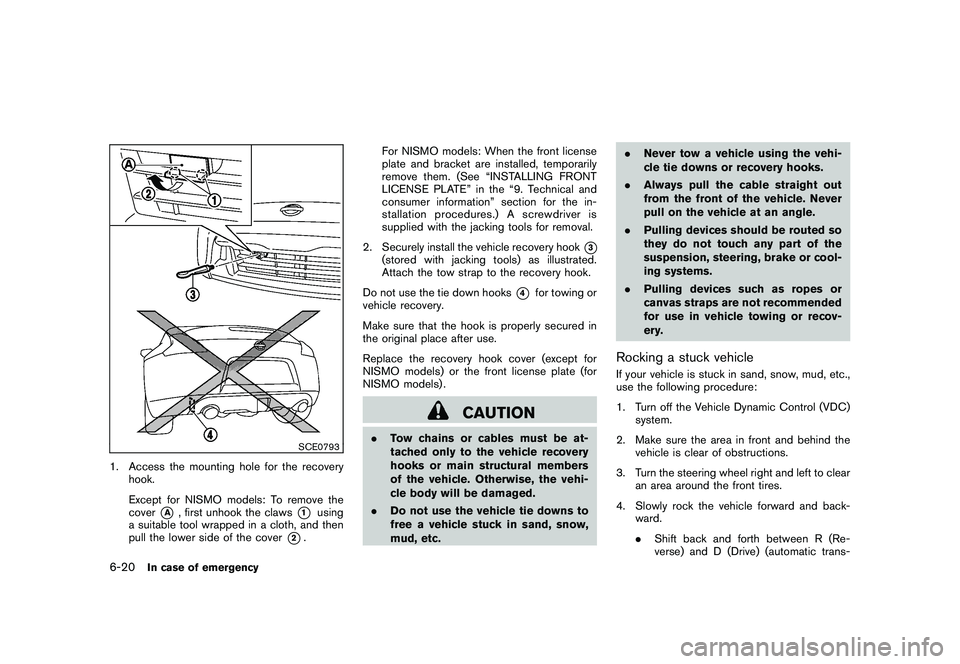
Black plate (332,1)
Model "Z34-D" EDITED: 2010/ 7/ 27
SCE0793
1. Access the mounting hole for the recoveryhook.
Except for NISMO models: To remove the
cover
*A
, first unhook the claws
*1
using
a suitable tool wrapped in a cloth, and then
pull the lower side of the cover
*2. For NISMO models: When the front license
plate and bracket are installed, temporarily
remove them. (See “INSTALLING FRONT
LICENSE PLATE” in the “9. Technical and
consumer information” section for the in-
stallation procedures.) A screwdriver is
supplied with the jacking tools for removal.
2. Securely install the vehicle recovery hook
*3
(stored with jacking tools) as illustrated.
Attach the tow strap to the recovery hook.
Do not use the tie down hooks
*4
for towing or
vehicle recovery.
Make sure that the hook is properly secured in
the original place after use.
Replace the recovery hook cover (except for
NISMO models) or the front license plate (for
NISMO models) .
CAUTION
. Tow chains or cables must be at-
tached only to the vehicle recovery
hooks or main structural members
of the vehicle. Otherwise, the vehi-
cle body will be damaged.
. Do not use the vehicle tie downs to
free a vehicle stuck in sand, snow,
mud, etc. .
Never tow a vehicle using the vehi-
cle tie downs or recovery hooks.
. Always pull the cable straight out
from the front of the vehicle. Never
pull on the vehicle at an angle.
. Pulling devices should be routed so
they do not touch any part of the
suspension, steering, brake or cool-
ing systems.
. Pulling devices such as ropes or
canvas straps are not recommended
for use in vehicle towing or recov-
ery.
Rocking a stuck vehicleIf your vehicle is stuck in sand, snow, mud, etc.,
use the following procedure:
1. Turn off the Vehicle Dynamic Control (VDC)
system.
2. Make sure the area in front and behind the vehicle is clear of obstructions.
3. Turn the steering wheel right and left to clear an area around the front tires.
4. Slowly rock the vehicle forward and back- ward.
.Shift back and forth between R (Re-
verse) and D (Drive) (automatic trans-
6-20
In case of emergency
Page 335 of 419
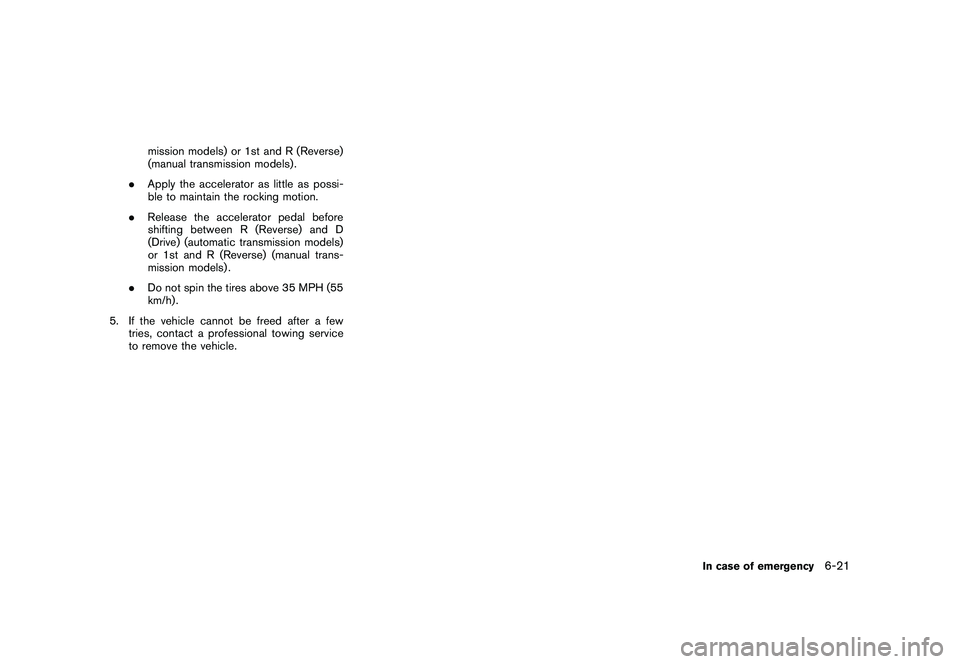
Black plate (333,1)
Model "Z34-D" EDITED: 2010/ 7/ 27
mission models) or 1st and R (Reverse)
(manual transmission models) .
. Apply the accelerator as little as possi-
ble to maintain the rocking motion.
. Release the accelerator pedal before
shifting between R (Reverse) and D
(Drive) (automatic transmission models)
or 1st and R (Reverse) (manual trans-
mission models) .
. Do not spin the tires above 35 MPH (55
km/h) .
5. If the vehicle cannot be freed after a few tries, contact a professional towing service
to remove the vehicle.
In case of emergency
6-21
Page 385 of 419

Black plate (28,1)
9 Technical and consumer information
Model "Z34-D" EDITED: 2010/ 7/ 28
Capacities and recommended fuel/lubricants............ 9-2
Fuel recommendation ...................................... 9-4
Engine oil and oil filter recommendation ............... 9-6
Air conditioning system refrigerant and lubricant
recommendations ........................................... 9-7
Specifications. ................................................... 9-8
Engine ......................................................... 9-8
Wheels and tires ............................................ 9-9
Dimensions ................................................. 9-10
When traveling or registering your vehicle in
another country ................................................ 9-11
Vehicle identification ......................................... 9-11
Vehicle Identification Number (VIN) plate ........... 9-11
Vehicle identification number (chassis number) .... 9-11
Engine serial number .................................... 9-12
F.M.V.S.S./C.M.V.S.S. certification label ............. 9-12
Emission control information label .................... 9-12
Tire and loading information label ..................... 9-13
Air conditioner specification label ..................... 9-13
Installing front license plate ................................ 9-14
Except for NISMO models .............................. 9-14
For NISMO models ...................................... 9-16 Removing air deflectors
(except for NISMO models)
................................ 9-17
Vehicle loading information ................................. 9-18
Terms ........................................................ 9-18
Vehicle load capacity .................................... 9-19
Loading tips ................................................ 9-20
Measurement of weights ................................ 9-20
Towing a trailer ................................................ 9-20
Flat towing ..................................................... 9-21
Automatic transmission .................................. 9-21
Manual Transmission ..................................... 9-21
Uniform tire quality grading ................................. 9-21
Treadwear .................................................. 9-21
Traction AA, A, B and C ................................ 9-21
Temperature A, B and C ................................ 9-22
Emission control system warranty ......................... 9-22
Reporting safety defects .................................... 9-23
Readiness for Inspection/Maintenance (I/M) test . . .... 9-24
Event Data Recorders (EDR) .............................. 9-24
Owner’s Manual/Service Manual order information . . . 9-25
In the event of a collision ............................... 9-25
Page 403 of 419
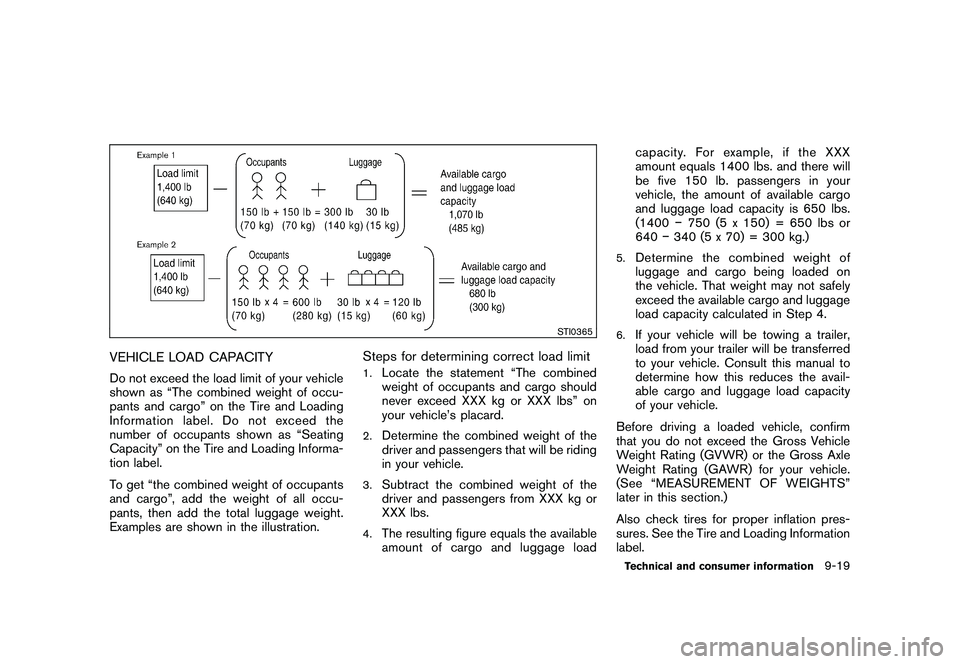
Black plate (403,1)
Model "Z34-D" EDITED: 2010/ 7/ 27
STI0365
VEHICLE LOAD CAPACITYDo not exceed the load limit of your vehicle
shown as “The combined weight of occu-
pants and cargo” on the Tire and Loading
Information label. Do not exceed the
number of occupants shown as “Seating
Capacity” on the Tire and Loading Informa-
tion label.
To get “the combined weight of occupants
and cargo”, add the weight of all occu-
pants, then add the total luggage weight.
Examples are shown in the illustration.
Steps for determining correct load limit1.
Locate the statement “The combined
weight of occupants and cargo should
never exceed XXX kg or XXX lbs” on
your vehicle’s placard.
2.
Determine the combined weight of the
driver and passengers that will be riding
in your vehicle.
3.
Subtract the combined weight of the
driver and passengers from XXX kg or
XXX lbs.
4.
The resulting figure equals the available
amount of cargo and luggage loadcapacity. For example, if the XXX
amount equals 1400 lbs. and there will
be five 150 lb. passengers in your
vehicle, the amount of available cargo
and luggage load capacity is 650 lbs.
(1400
�750 (5 x 150) = 650 lbs or
640 �340 (5 x 70) = 300 kg.)
5.
Determine the combined weight of
luggage and cargo being loaded on
the vehicle. That weight may not safely
exceed the available cargo and luggage
load capacity calculated in Step 4.
6.
If your vehicle will be towing a trailer,
load from your trailer will be transferred
to your vehicle. Consult this manual to
determine how this reduces the avail-
able cargo and luggage load capacity
of your vehicle.
Before driving a loaded vehicle, confirm
that you do not exceed the Gross Vehicle
Weight Rating (GVWR) or the Gross Axle
Weight Rating (GAWR) for your vehicle.
(See “MEASUREMENT OF WEIGHTS”
later in this section.)
Also check tires for proper inflation pres-
sures. See the Tire and Loading Information
label.Technical and consumer information
9-19
Page 404 of 419

Black plate (404,1)
Model "Z34-D" EDITED: 2010/ 7/ 27
LOADING TIPS.
The GVW must not exceed GVWR or
GAWR as specified on the F.M.V.S.S./
C.M.V.S.S. certification label.
.
Do not load the front and rear axle to
the GAWR. Doing so will exceed the
GVWR.
WARNING
.
Properly secure all cargo to help
prevent it from sliding or shift-
ing. Do not place cargo higher
than the seatbacks. In a sudden
stop or collision, unsecured car-
go could cause personal injury.
.
Do not load your vehicle any
heavier than the GVWR or the
maximum front and rear
GAWRs. If you do, parts of your
vehicle can break, tire damage
could occur, or it can change the
way your vehicle handles. This
could result in loss of control
and cause personal injury.
.
Overloading could not only
shorten the life of your vehicle
and the tires, but also could leadto hazardous vehicle handling
and long braking distance. This
may cause a premature tire
malfunction, which could result
in a serious accident and perso-
nal injury. Failures caused by
overloading are not covered by
the vehicle’s warranty.
MEASUREMENT OF WEIGHTSSecure loose items to prevent weight shifts
that could affect the balance of your
vehicle. When the vehicle is loaded, drive
to a scale and weigh the front and the rear
wheels separately to determine axle loads.
Individual axle loads should not exceed
either of the gross axle weight ratings
(GAWR) . The total of the axle loads should
not exceed the gross vehicle weight rating
(GVWR) . These ratings are given on the
vehicle certification label. If weight ratings
are exceeded, move or remove items to
bring all weights below the ratings.
Do not tow a trailer with your vehicle.TOWING A TRAILER
9-20
Technical and consumer information
Page 405 of 419
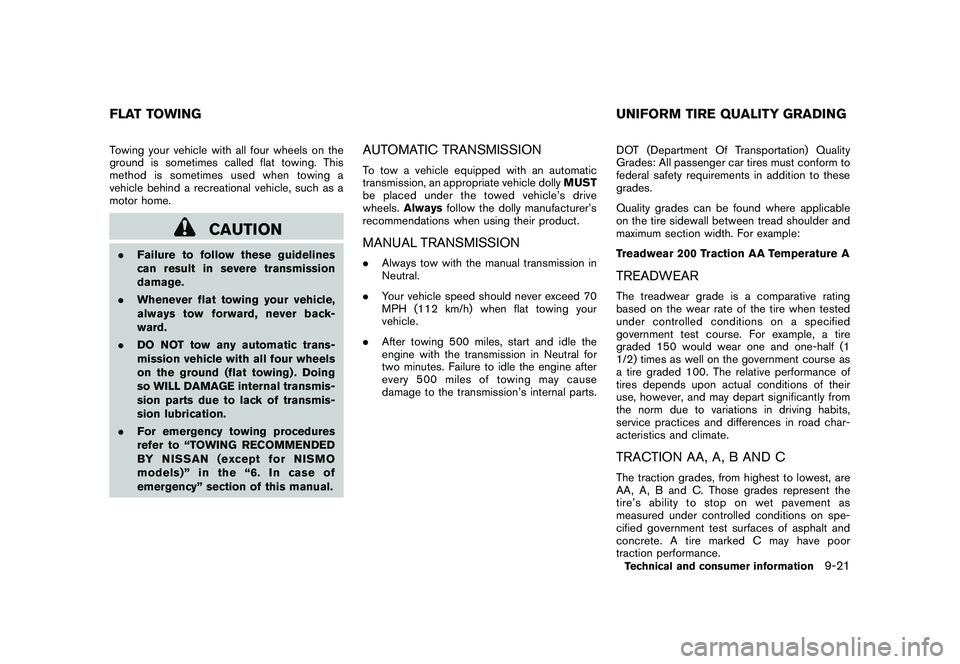
Black plate (405,1)
Model "Z34-D" EDITED: 2010/ 7/ 27
Towing your vehicle with all four wheels on the
ground is sometimes called flat towing. This
method is sometimes used when towing a
vehicle behind a recreational vehicle, such as a
motor home.
CAUTION
.Failure to follow these guidelines
can result in severe transmission
damage.
. Whenever flat towing your vehicle,
always tow forward, never back-
ward.
. DO NOT tow any automatic trans-
mission vehicle with all four wheels
on the ground (flat towing) . Doing
so WILL DAMAGE internal transmis-
sion parts due to lack of transmis-
sion lubrication.
. For emergency towing procedures
refer to “TOWING RECOMMENDED
BY NISSAN (except for NISMO
models)” in the “6. In case of
emergency” section of this manual.
AUTOMATIC TRANSMISSIONTo tow a vehicle equipped with an automatic
transmission, an appropriate vehicle dolly MUST
be placed under the towed vehicle’s drive
wheels. Always follow the dolly manufacturer’s
recommendations when using their product.MANUAL TRANSMISSION. Always tow with the manual transmission in
Neutral.
. Your vehicle speed should never exceed 70
MPH (112 km/h) when flat towing your
vehicle.
. After towing 500 miles, start and idle the
engine with the transmission in Neutral for
two minutes. Failure to idle the engine after
every 500 miles of towing may cause
damage to the transmission’s internal parts. DOT (Department Of Transportation) Quality
Grades: All passenger car tires must conform to
federal safety requirements in addition to these
grades.
Quality grades can be found where applicable
on the tire sidewall between tread shoulder and
maximum section width. For example:
Treadwear 200 Traction AA Temperature A
TREADWEARThe treadwear grade is a comparative rating
based on the wear rate of the tire when tested
under controlled conditions on a specified
government test course. For example, a tire
graded 150 would wear one and one-half (1
1/2) times as well on the government course as
a tire graded 100. The relative performance of
tires depends upon actual conditions of their
use, however, and may depart significantly from
the norm due to variations in driving habits,
service practices and differences in road char-
acteristics and climate.TRACTION AA, A, B AND CThe traction grades, from highest to lowest, are
AA, A, B and C. Those grades represent the
tire’s ability to stop on wet pavement as
measured under controlled conditions on spe-
cified government test surfaces of asphalt and
concrete. A tire marked C may have poor
traction performance.
FLAT TOWING
UNIFORM TIRE QUALITY GRADING
Technical and consumer information
9-21
Page 412 of 419
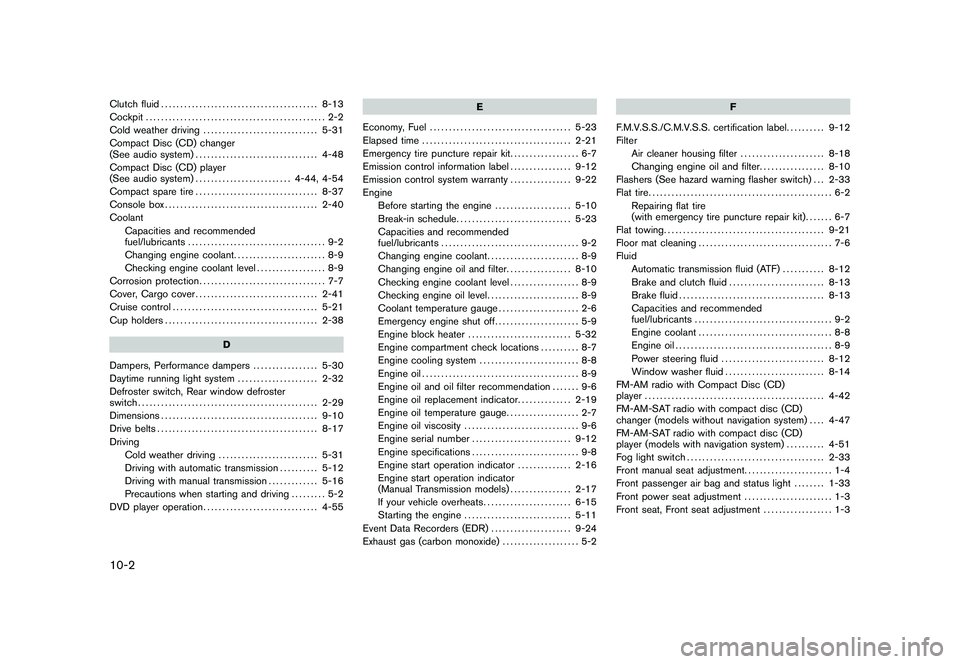
Black plate (2,1)
10-2Clutch fluid......................................... 8-13
Cockpit ............................................... 2-2
Cold weather driving .............................. 5-31
Compact Disc (CD) changer
(See audio system) ................................ 4-48
Compact Disc (CD) player
(See audio system) ......................... 4-44, 4-54
Compact spare tire ................................ 8-37
Console box ........................................ 2-40
Coolant Capacities and recommended
fuel/lubricants .................................... 9-2
Changing engine coolant ........................ 8-9
Checking engine coolant level .................. 8-9
Corrosion protection ................................. 7-7
Cover, Cargo cover ................................ 2-41
Cruise control ...................................... 5-21
Cup holders ........................................ 2-38
D
Dampers, Performance dampers ................. 5-30
Daytime running light system ..................... 2-32
Defroster switch, Rear window defroster
switch ............................................... 2-29
Dimensions ......................................... 9-10
Drive belts .......................................... 8-17
Driving Cold weather driving .......................... 5-31
Driving with automatic transmission .......... 5-12
Driving with manual transmission ............. 5-16
Precautions when starting and driving ......... 5-2
DVD player operation .............................. 4-55 E
Economy, Fuel ..................................... 5-23
Elapsed time ....................................... 2-21
Emergency tire puncture repair kit .................. 6-7
Emission control information label ................ 9-12
Emission control system warranty ................ 9-22
Engine Before starting the engine .................... 5-10
Break-in schedule .............................. 5-23
Capacities and recommended
fuel/lubricants .................................... 9-2
Changing engine coolant ........................ 8-9
Changing engine oil and filter ................. 8-10
Checking engine coolant level .................. 8-9
Checking engine oil level ........................ 8-9
Coolant temperature gauge ..................... 2-6
Emergency engine shut off ...................... 5-9
Engine block heater ........................... 5-32
Engine compartment check locations .......... 8-7
Engine cooling system .......................... 8-8
Engine oil ......................................... 8-9
Engine oil and oil filter recommendation ....... 9-6
Engine oil replacement indicator .............. 2-19
Engine oil temperature gauge ................... 2-7
Engine oil viscosity .............................. 9-6
Engine serial number .......................... 9-12
Engine specifications ............................ 9-8
Engine start operation indicator .............. 2-16
Engine start operation indicator
(Manual Transmission models) ................ 2-17
If your vehicle overheats ....................... 6-15
Starting the engine ............................ 5-11
Event Data Recorders (EDR) ..................... 9-24
Exhaust gas (carbon monoxide) .................... 5-2 F
F.M.V.S.S./C.M.V.S.S. certification label. ......... 9-12
Filter Air cleaner housing filter ...................... 8-18
Changing engine oil and filter ................. 8-10
Flashers (See hazard warning flasher switch) . . . 2-33
Flat tire ................................................ 6-2
Repairing flat tire
(with emergency tire puncture repair kit) ....... 6-7
Flat towing .......................................... 9-21
Floor mat cleaning ................................... 7-6
Fluid Automatic transmission fluid (ATF) ........... 8-12
Brake and clutch fluid ......................... 8-13
Brake fluid ...................................... 8-13
Capacities and recommended
fuel/lubricants .................................... 9-2
Engine coolant ................................... 8-8
Engine oil ......................................... 8-9
Power steering fluid ........................... 8-12
Window washer fluid .......................... 8-14
FM-AM radio with Compact Disc (CD)
player ............................................... 4-42
FM-AM-SAT radio with compact disc (CD)
changer (models without navigation system) .... 4-47
FM-AM-SAT radio with compact disc (CD)
player (models with navigation system) .......... 4-51
Fog light switch .................................... 2-33
Front manual seat adjustment. ...................... 1-4
Front passenger air bag and status light ........ 1-33
Front power seat adjustment ....................... 1-3
Front seat, Front seat adjustment .................. 1-3
Model "Z34-D" EDITED: 2010/ 7/ 28
Page 416 of 419
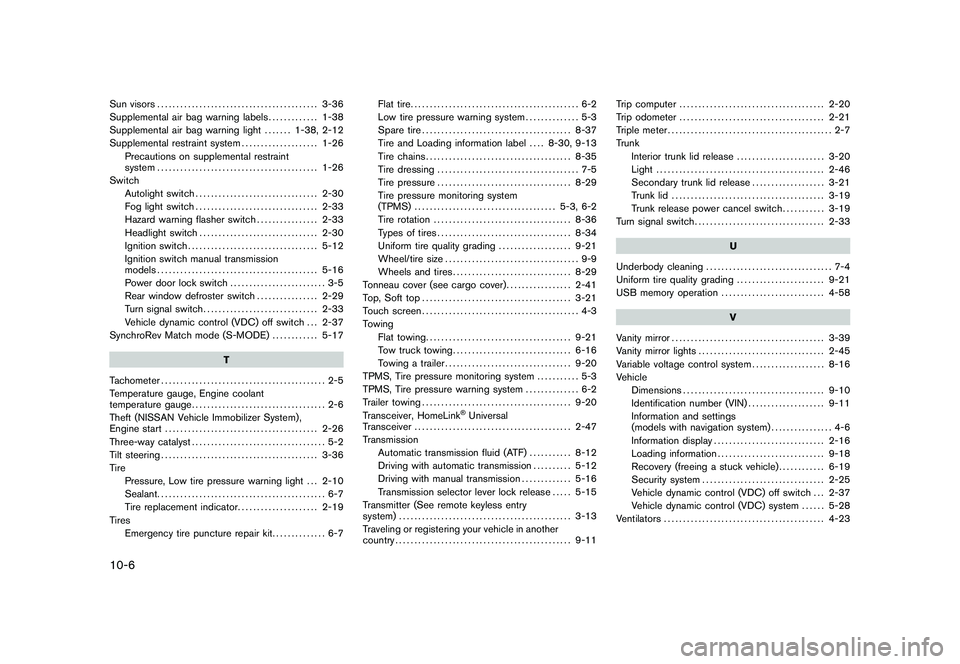
Black plate (6,1)
10-6Sun visors.......................................... 3-36
Supplemental air bag warning labels ............. 1-38
Supplemental air bag warning light ....... 1-38, 2-12
Supplemental restraint system .................... 1-26
Precautions on supplemental restraint
system .......................................... 1-26
Switch Autolight switch ................................ 2-30
Fog light switch ................................ 2-33
Hazard warning flasher switch ................ 2-33
Headlight switch ............................... 2-30
Ignition switch .................................. 5-12
Ignition switch manual transmission
models .......................................... 5-16
Power door lock switch ......................... 3-5
Rear window defroster switch ................ 2-29
Turn signal switch .............................. 2-33
Vehicle dynamic control (VDC) off switch . . . 2-37
SynchroRev Match mode (S-MODE) ............ 5-17
T
Tachometer ........................................... 2-5
Temperature gauge, Engine coolant
temperature gauge ................................... 2-6
Theft (NISSAN Vehicle Immobilizer System) ,
Engine start ........................................ 2-26
Three-way catalyst ................................... 5-2
Tilt steering ......................................... 3-36
Tire Pressure, Low tire pressure warning light . . . 2-10
Sealant ............................................ 6-7
Tire replacement indicator ..................... 2-19
Tires Emergency tire puncture repair kit .............. 6-7Flat tire
............................................ 6-2
Low tire pressure warning system .............. 5-3
Spare tire ....................................... 8-37
Tire and Loading information label .... 8-30, 9-13
Tire chains ...................................... 8-35
Tire dressing ..................................... 7-5
Tire pressure ................................... 8-29
Tire pressure monitoring system
(TPMS) ..................................... 5-3, 6-2
Tire rotation .................................... 8-36
Types of tires ................................... 8-34
Uniform tire quality grading ................... 9-21
Wheel/tire size ................................... 9-9
Wheels and tires ............................... 8-29
Tonneau cover (see cargo cover) ................. 2-41
Top, Soft top ....................................... 3-21
Touch screen ......................................... 4-3
Towing Flat towing ...................................... 9-21
Tow truck towing ............................... 6-16
Towing a trailer ................................. 9-20
TPMS, Tire pressure monitoring system ........... 5-3
TPMS, Tire pressure warning system .............. 6-2
Trailer towing ....................................... 9-20
Transceiver, HomeLink
®Universal
Transceiver ......................................... 2-47
Transmission Automatic transmission fluid (ATF) ........... 8-12
Driving with automatic transmission .......... 5-12
Driving with manual transmission ............. 5-16
Transmission selector lever lock release ..... 5-15
Transmitter (See remote keyless entry
system) ............................................. 3-13
Traveling or registering your vehicle in another
country .............................................. 9-11 Trip computer
...................................... 2-20
Trip odometer ...................................... 2-21
Triple meter ........................................... 2-7
Trunk Interior trunk lid release ....................... 3-20
Light ............................................ 2-46
Secondary trunk lid release ................... 3-21
Trunk lid ........................................ 3-19
Trunk release power cancel switch ........... 3-19
Turn signal switch .................................. 2-33
U
Underbody cleaning ................................. 7-4
Uniform tire quality grading ....................... 9-21
USB memory operation ........................... 4-58
V
Vanity mirror ........................................ 3-39
Vanity mirror lights ................................. 2-45
Variable voltage control system ................... 8-16
Vehicle Dimensions ..................................... 9-10
Identification number (VIN) .................... 9-11
Information and settings
(models with navigation system) ................ 4-6
Information display ............................. 2-16
Loading information ............................ 9-18
Recovery (freeing a stuck vehicle) ............ 6-19
Security system ................................ 2-25
Vehicle dynamic control (VDC) off switch . . . 2-37
Vehicle dynamic control (VDC) system ...... 5-28
Ventilators .......................................... 4-23
Model "Z34-D" EDITED: 2010/ 7/ 28